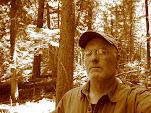When I find a good place to canoe, I most often return there repeatedly. In part, this is to experience the area under different conditions and in various times of the year. But, it is also to give me a chance to explore the surroundings and research features that I can see from the water.
I set out for Rocky Hill where there is a nice stretch of the Connecticut River that I paddle a few times each year. But, I change my mind while on the drive and divert to the Salmon River, just because I find it a comfortable place to be. I found this spot after crossing the Connecticut River from Haddam and being confronted with an absurd number of U.S. Government No Trespassing signs - about one on every third tree along the river bank. It turned out to be the former site of a nuclear power plant, which had been removed prior to my moving to the area. Coming back and entering from the better located launch at the bottom of Salmon Cove, I found a large area of undeveloped forest land in an area that is prime property for the various concoctions of the infamous Mr. and Mrs. Moneybags. More research turned up the fact that the spent nuclear fuel rods are stored onsite, but well out of view. The entirety of the power plant property and some former private property remains as a rare no trespassing National Wildlife Refuge. Reading one day about Connecticut archaeology, I discovered that Dibble Creek, which tumbles, or dribbles, into the cove, if you know where to look, was the site of a hunting camp dating to 3000-6000 years ago. This same reading uncovered Venture Smith. Smith's farm is on top of the hill overlooking the Salmon River as it enters the cove. It is about a 100 acres. The interesting part of the story is that Venture Smith was captured in Africa in the 1730's and brought to America as a slave, eventually ending up in Stonington, CT. His master allowed him to work odd jobs in his spare time to earn money, which he used to buy his own freedom. He then set about farming and fishing until he could buy the freedom of his wife and children, after which he bought and began farming and fishing the land I paddle under. His grave is in a nearby churchyard cemetery.
 |
| The Moodus Beaver Dam |
 |
| The Dibble Creek Dam |
I head up the cove and into the Moodus River. The lowest beaver dam is out of the water about 3 inches - I can slip over it without getting out of the canoe. The next beaver dam, which is not maintained anymore, is submerged. I turn back at the tight bend below Johnsonville, the wade to get by the gravel bar not being worth the effort for the last 200 yards below the old Johnsoville Dam. Johnsonville is the lowest of 13 yarn mills that were on the Moodus. I'm glad to be coming back out as the greenhead flies are excited. They are a biting fly, although not as voracious or numerous as the black flies that NE canoeists are familiar with (I've never seen black flies in Connecticut).
The wind has come up, so it is a bit of work getting back down the cove. I stop briefly at the bay below Dibble Creek. There is an old beaver dam here that can be crossed at high water - actually, you can cross it anytime, but the other side of it is much too shallow except at high water. Anyway, it looks nothing like a dam today as it is fully vegetated and camouflaged with shrubs and saplings - that's how I know it to be an old dam.
From there, I head out. It was not just a canoe trip, but a day out surrounded by and connected to a landscape of significance.


No comments:
Post a Comment